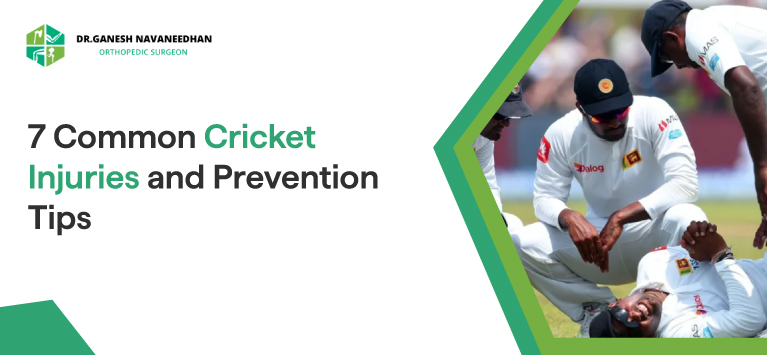- +91 62384 78716 +91 99475 78797
-
Sasthamangalam, Trivandrum
Sasthamangalam, Trivandrum

Cricket, a sport steeped in tradition with millions of fans worldwide, necessitates outstanding athleticism and resilience. While the exciting competition fuels our passion, it also carries the risk of injury. Knowing the most common cricket sport injuries helps players better understand their bodies and take energetic measures to prevent them.
In this blog, we’ll look at the seven most common cricket injuries, as well as the causes, symptoms, and preventive measures that can help you stay in the game.
Here are the most frequent injuries faced by cricketers:
Sprains and strains are two of the most frequent cricket wounds. They occur when ligaments or muscles are stretched or torn due to sudden twists, turns, or overexertion. Bowling, fielding, or batting actions often contribute to these injuries.
Symptoms include pain, swelling, and limited movement. To prevent sprains and strains, warm-up exercises, stretching routines, and regular conditioning are essential. If an injury occurs, rest, ice, compression, and elevation (RICE) can aid in recovery.
The repetitive nature of bowling and throwing can lead to shoulder injuries, including rotator cuff tears, impingement syndrome, and tendonitis. Symptoms may include pain, weakness, and reduced range of motion.
Proper technique, regular shoulder strengthening exercises, and implementing adequate rest periods can minimize the risk of shoulder injuries. It is crucial to seek medical attention promptly for severe or persistent symptoms.
Cricket involves repetitive bending, twisting, and sudden movements, placing strain on the lower back. Bowlers, in particular, are prone to developing lower back pain. Poor bowling technique, insufficient core strength, and inadequate warm-up can contribute to this injury.
Preventive measures include maintaining good posture, regular core strengthening exercises, and following correct bowling biomechanics. Rest, physical therapy, and activities targeting the lower back can help treat and manage this condition.
Hamstring strains are caused by overstretching or tearing of the muscles at the back of the thigh. Sudden acceleration or deceleration while running, bowling, or fielding can cause this injury. Symptoms include sharp pain, tenderness, and swelling.
To prevent hamstring strains, players should focus on regular flexibility exercises, dynamic warm-ups, and progressive training programs. Adequate rest, ice, and physiotherapy techniques are crucial in the recovery process.
Quick direction changes, uneven playing surfaces, and missteps can result in ankle injuries, such as sprained ankles or fractures. The discomfort, swollen joints, bruises, and difficulty bearing weight are some of the symptoms.
Wearing proper cricket shoes with ankle support, performing balance and proprioception exercises, and using ankle taping or bracing can aid in preventing ankle injuries. Even Hardik Pandya has been injured in the ankle during a clash against Bangladesh.
A side strain, also known as an oblique muscle strain, is a commonly encountered injury in cricket, especially among fast bowlers. It results from excessive stress placed on the side muscles during the bowling action. Typical symptoms include sudden onset of pain in the side or abdomen area.
Proper warm-up, gradual increase in bowling loads, and strengthening exercises targeting the oblique muscles can help prevent side strains. Rest, physiotherapy, and gradual return-to-play protocols are crucial for a full recovery.
Cricket involves catching, fielding, and batting activities, making fingers susceptible to fractures, dislocations, and ligament damage. Symptoms include pain, swelling, and difficulty gripping or flexing the finger.
Wearing appropriate protective gear, such as gloves, and ensuring proper catching and fielding techniques can reduce the risk of finger injuries. Early medical assessment and treatment are necessary to promote good healing.
Now that you’re familiar with the common foes, here are some ways to avoid them and stay injury-free:
When injuries strike, players need proper care and recovery time. Rushing back onto the field without adequate healing can exacerbate injuries and lead to prolonged problems. Proper rehabilitation under expert sports medicine doctor is vital for a safe return to the game.
Injuries in cricket are a part of the game, but with preventive measures and timely care, players can minimize their impact. By incorporating proper warm-up routines, strengthening exercises, and practising good technique, players can significantly reduce the risk of these injuries.
Additionally, listening to their bodies, seeking early medical attention, and allowing adequate time for rest and recovery are crucial steps in managing and treating cricket injuries.
Remember, staying fit, maintaining good conditioning, and prioritizing injury-prevention strategies are vital to enjoying the game of cricket for years to come!
Copyright © 2025 Dr. Ganesh Navaneedhan. All Rights Reserved. | Designed By Harvee healthcare